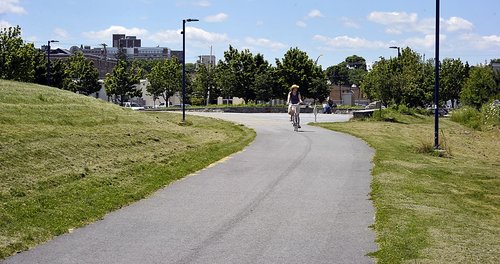The “missing link” to Portland’s goal of building a multiuse path around the peninsula is finally in sight.
State transportation officials have freed up grant funds for the city to begin planning to connect the Bayside Trail to the Portland Transportation Center by way of Elm Street, Forest Avenue and Deering Oaks. Now city staff will consider the final route for the extension of the Bayside Trail.
The project not only will add to the city’s appeal, it will enhance an up-and-coming neighborhood. Completing the Bayside Trail will encourage more commuters who walk or ride bicycles, a fitting endeavor in a city known for being livable, walkable and environmentally friendly.
The trail is relatively lightly used now, but with Bayside on the verge of major development, it will be an amenity for residents, offering them green space and a place to interact. Everybody benefits.
The final route of the Bayside Trail extension won’t be a pastoral one, since the proposed route would encompass the busy intersection of Marginal Way and Preble Street. The extended Bayside Trail, however, will be better equipped to serve as a connector, one of its primary roles.
The planned extension to Libbytown of the trail — which now ends at Elm Street — will make the trail a way for pedestrian and bicycle commuters to get across the peninsula. It’s to the city’s benefit as well, since any proposal that makes it easier to get along without a car will draw people who prefer to do so.
Some of the new residents undoubtedly will be right in the neighborhood. Developers are moving ahead with both low-income and market-rate housing in Bayside, which is attracting new and expanding businesses. The trail allows residents access to these retailers, restaurants, houses of worship and grocery stores.
For one of the largest developments, midtown, which incorporates little parks along the trail, the trail is an asset. And out on the trail, the hundreds of residents of midtown and other proposed developments will add to the neighborhood’s comings and goings, discouraging crime as they enjoy the public space.
The Bayside Trail may not offer the scenic vistas of the Back Cove Trail, but then again, it’s not meant to be a destination trail — it’s meant to connect people to other trails in Portland. Through the redesign of Franklin Street, which currently cuts the Bayside Trail in two sections, the city has already started to address one major obstacle to the use of the trail. Now, given access to funds to plan an extension, Portland officials have a chance to make the trail a vital part of a vital urban neighborhood.
Send questions/comments to the editors.



Success. Please wait for the page to reload. If the page does not reload within 5 seconds, please refresh the page.
Enter your email and password to access comments.
Hi, to comment on stories you must . This profile is in addition to your subscription and website login.
Already have a commenting profile? .
Invalid username/password.
Please check your email to confirm and complete your registration.
Only subscribers are eligible to post comments. Please subscribe or login first for digital access. Here’s why.
Use the form below to reset your password. When you've submitted your account email, we will send an email with a reset code.